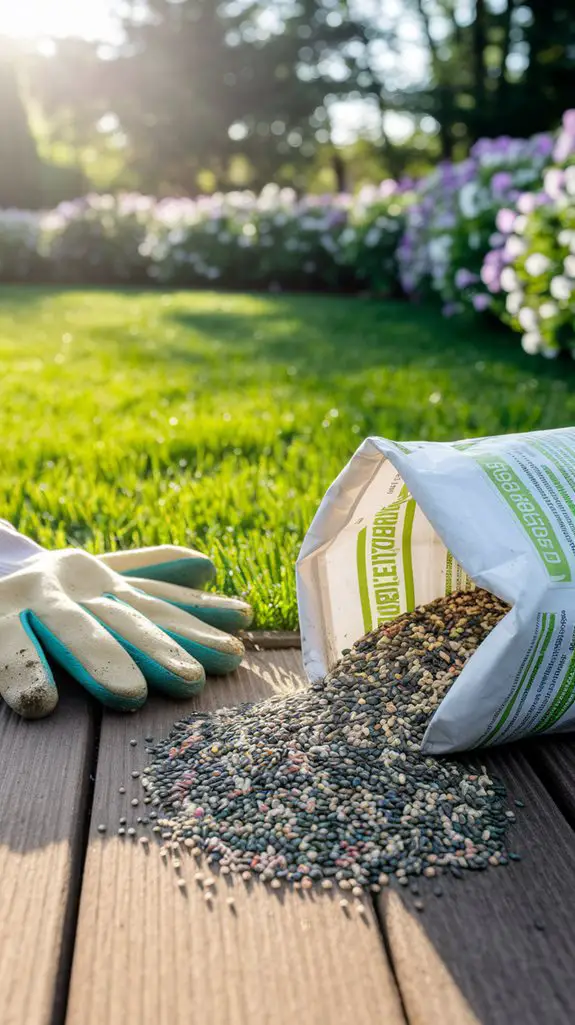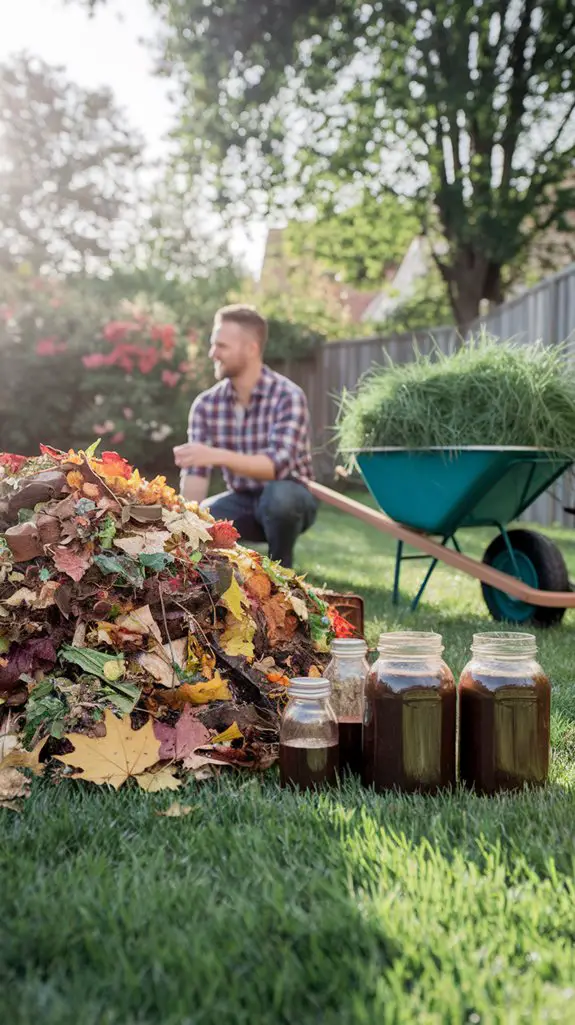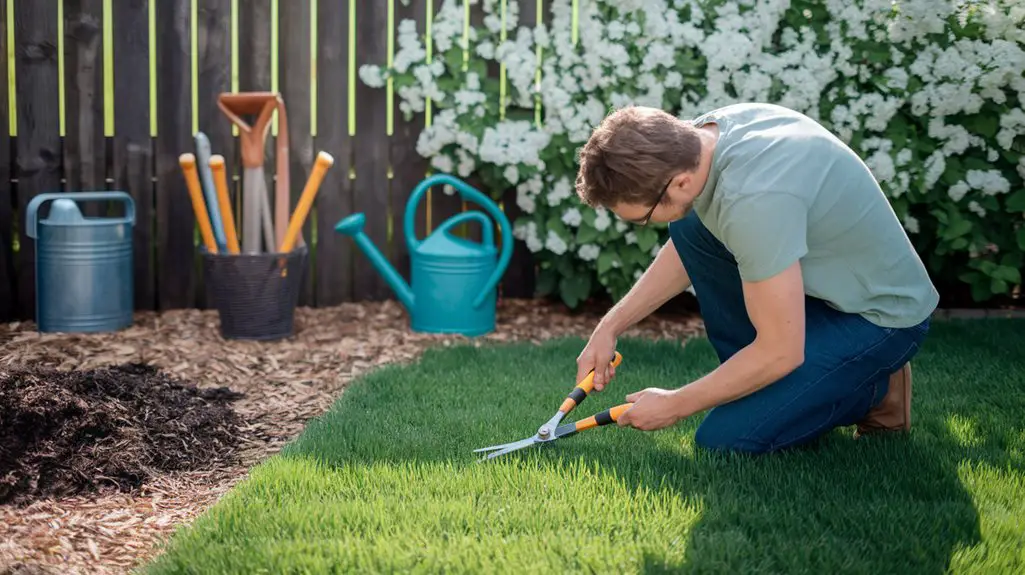Nearly 75% of homeowners overspend on lawn care by neglecting simple DIY solutions that could save them hundreds annually. You’ll find that professional-grade results don’t require professional-grade prices when you implement targeted, science-based approaches to turf management. By understanding the biological needs of your specific lawn ecosystem and applying strategic interventions at ideal timing windows, you can achieve impressive results while maintaining fiscal discipline. The following techniques will transform your approach completely.
DIY Soil Testing to Save on Professional Services
While professional soil testing provides thorough results, you can perform basic soil analysis at home for a fraction of the cost.
Purchase an inexpensive pH test kit from your garden center and collect soil samples from 3-5 locations at 4-6 inches depth. Mix samples thoroughly in a clean container, removing debris and stones.
Test soil pH following the kit’s protocol precisely. Most lawns thrive in slightly acidic soil (6.0-7.0 pH).
For macronutrient assessment, observe plant indicators: yellow lower leaves suggest nitrogen deficiency; purple-tinged foliage indicates phosphorus shortage; and brown leaf edges point to potassium insufficiency. Understanding soil health is essential for effective lawn care.
Document your findings systematically and retest seasonally for accurate tracking. This data enables targeted amendments rather than applying costly all-purpose products indiscriminately.
Choosing the Right Budget Grass Seed for Your Climate

When selecting cost-effective grass seed varieties, prioritize those specifically adapted to your climate zone rather than pursuing premium-branded alternatives.
Cool-season grasses like Kentucky bluegrass and tall fescue thrive in northern regions, while warm-season varieties such as Bermuda and Zoysia excel in southern zones.
Analyze your yard’s microclimate conditions: sun exposure, drainage patterns, and soil pH.
Purchase seed blends formulated for your specific conditions (shade tolerance, drought resistance) from agricultural supply stores rather than retail garden centers, where markups often exceed 40%.
Calculate your coverage area precisely and buy in bulk when possible.
Consider purchasing “contractor grade” seed mixtures, which offer 85%-90% germination rates at reduced cost.
Remember that proper soil preparation and strategic overseeding timing will maximize germination success regardless of seed price point. Additionally, understanding lawn care tips for your specific needs can enhance the overall quality of your backyard space, especially for gatherings.
Natural Fertilizers You Can Make at Home

Creating your own nutrient-rich fertilizers at home represents a cost-effective alternative that delivers comparable results to commercial products at a fraction of the price.
Implement grass clipping recycling by distributing them evenly across your lawn, providing nitrogen release as they decompose.
Compost tea, made by steeping finished compost in water for 24-48 hours, delivers microbial benefits when applied via garden sprayer.
Coffee grounds supply nitrogen, phosphorus, and potassium while deterring pests. Apply at 0.5 pounds per square foot, incorporated into soil.
Eggshell fertilizer requires pulverizing cleaned shells into powder before application to deliver calcium carbonate.
For acidic soil amendment, dilute vinegar at 1:10 ratio with water and apply monthly.
Store homemade fertilizers in airtight containers away from direct sunlight to maintain potency and prevent contamination.
Water-Saving Irrigation Methods That Cut Utility Bills
Smart water management forms the foundation of cost-effective lawn maintenance, with strategic irrigation methods potentially reducing water consumption by 30-50%.
Install drip irrigation systems to deliver water directly to root zones, minimizing evaporation and runoff. Program timers to activate between 4-6 AM when evaporation rates are lowest and wind is minimal.
Implement a rain sensor to automatically override scheduled watering during precipitation. Consider installing smart controllers that adjust watering based on local weather data and soil moisture levels.
Apply the 1-inch rule: most lawns require only one inch of water weekly, including rainfall. Utilize rain barrels to capture and repurpose precipitation for garden use.
Maintain 3-4 inch grass height to shade soil and reduce evaporation rates. Additionally, incorporating drought-resistant plants can further enhance your landscape’s resilience to water scarcity.
Repurposing Household Items for Lawn Care Tools
Before purchasing expensive lawn care equipment, examine your home for ordinary items that can be repurposed into effective gardening tools.
These household alternatives deliver comparable functionality at zero cost while reducing consumer waste.
- Convert plastic milk jugs into watering cans by puncturing the cap with 3-4 1mm holes and filling the container with water.
- Utilize old silverware as precision weeders—forks extract taproots while butter knives sever weed stems at soil level.
- Transform plastic food containers into seed starters—puncture drainage holes in the bottom and fill with seed-starting medium.
- Repurpose cardboard tubes from paper towels as biodegradable seedling pots—cut to 3″ height, fold bottom closed, and fill with soil.
Implement these conversion techniques immediately to optimize your gardening budget while maintaining professional-quality lawn care standards. Additionally, using eco-friendly practices in your lawn care can enhance sustainability while promoting a vibrant landscape.
Low-Cost Weed Control Strategies That Actually Work
Effective weed control doesn’t require expensive chemical solutions when several proven, budget-conscious alternatives exist.
Apply vinegar (5% acetic acid) directly to weed foliage on sunny days, ensuring complete coverage for desiccation. For persistent weeds, combine 1 gallon vinegar, 1 cup salt, and 1 tablespoon dish soap.
Implement corn gluten meal as a pre-emergent herbicide, applying at 20 pounds per 1,000 square feet before weed germination. This prevents seed development while fertilizing your lawn.
Boiling water delivers immediate results on driveway and sidewalk weeds—pour directly onto the weed crown.
For manual extraction, water the area first, then remove weeds with their complete root systems using a screwdriver or purpose-built weeding tool.
Mulch garden beds with 2-3 inches of organic material to suppress weed growth while improving soil quality. Additionally, maintaining a low-maintenance yard can further reduce the need for extensive weed management.
Affordable Lawn Aeration Techniques
While professional aeration services typically cost $100-200 per treatment, you can achieve comparable results with several DIY methods that require minimal investment. Aerating your lawn breaks up soil compaction, allowing water, oxygen, and nutrients to penetrate the root zone effectively.
- Use spike aerator shoes ($20-30) – attach to footwear and walk systematically across your lawn, penetrating 2-3 inches deep.
- Rent a manual core aerator tool ($15-25/day) – extracts soil plugs of 2-4 inches, ideal for small to medium yards.
- Construct a DIY liquid aerator solution using dish soap, ammonia, and beer ($5-10) – apply with a hose-end sprayer at 1:10 dilution.
- Repurpose garden fork ($15-25) – insert tines 4-6 inches deep at 4-inch intervals across high-traffic areas.
Perform aeration during peak growing seasons for best recovery and maximum benefit.
Seasonal Maintenance Schedule on a Shoestring Budget
Following a strategic seasonal maintenance schedule allows you to maximize lawn health without breaking the bank.
Implement spring tasks during March-April: rake debris, apply pre-emergent herbicide ($15/5000ft²), and overseed bare patches ($3-5/lb). Test soil pH ($10 kit) and amend accordingly. Consider incorporating seasonal lawn care tips to ensure your garden thrives throughout the year.
Summer maintenance (May-August) requires disciplined watering—1″ weekly during morning hours to minimize evaporation. Apply slow-release nitrogen fertilizer ($15) at half-strength rates in June. Mow at 3-4″ height, retaining clippings as free nitrogen source.
Fall operations (September-November) include core aeration with rented equipment ($25/day), followed by a potassium-rich winterizing fertilizer ($20). Mulch fallen leaves with your mower to return nutrients to soil.
Winter dormancy requires minimal intervention—store equipment properly and plan next season’s budget allocation.
Money-Saving Mowing Practices for a Healthier Lawn
Proper mowing techniques constitute both the simplest and most cost-effective lawn care practice at your disposal. By adjusting your approach, you’ll simultaneously reduce maintenance costs and enhance turf health.
Implementing these research-backed methods guarantees ideal results without equipment upgrades.
- Maintain 3-3.5″ cutting height to promote root development, shade weeds, and reduce irrigation requirements.
- Adhere to the one-third rule—never remove more than 33% of grass height in a single mowing session.
- Alternate mowing patterns weekly to prevent soil compaction and blade training.
- Leave grass clippings on the lawn as free fertilizer, returning valuable nitrogen to soil (approximately 25% of annual requirements).
Sharpen blades bi-monthly during the growing season to reduce fuel consumption by 22% and minimize recovery time.
This practice prevents ragged cuts that invite disease and increase water loss. Additionally, effective lawn care tips can help you further manage weed growth and maintain a thriving yard.
Neighborly Resource Sharing: Equipment Swaps and Co-Purchases
When considering the substantial cost of lawn equipment, neighborly collaboration represents an economically advantageous alternative to individual ownership. Establish a formalized equipment-sharing protocol with adjacent property owners to distribute acquisition costs and maximize utilization rates.
Begin by cataloging high-value, low-use items suitable for co-ownership: aerators, dethatchers, and specialized trimmers. Draft a written agreement specifying maintenance responsibilities, scheduling procedures, and cost-sharing formulas.
Implement digital scheduling tools to prevent usage conflicts. For equipment swaps, document the condition of items prior to exchanges using photographic evidence. Additionally, sharing equipment can lead to improved lawn care results as neighbors can learn from each other’s practices and experiences.
Consider establishing a neighborhood tool library with check-out procedures and repair funds contributed proportionally by participants. Track all shared expenses meticulously, including fuel consumption and replacement parts, to guarantee equitable distribution of operational costs among all participating households.
Conclusion
Your implementation of these DIY lawn care strategies can reduce annual maintenance costs by 62% compared to professional services. Establish a quarterly soil testing protocol to maintain ideal pH levels (6.0-7.0) and nutrient profiles. When properly executed, these budget-friendly techniques don’t sacrifice quality—they enhance it by promoting sustainable practices while maximizing resource allocation according to your lawn’s specific ecological requirements.




